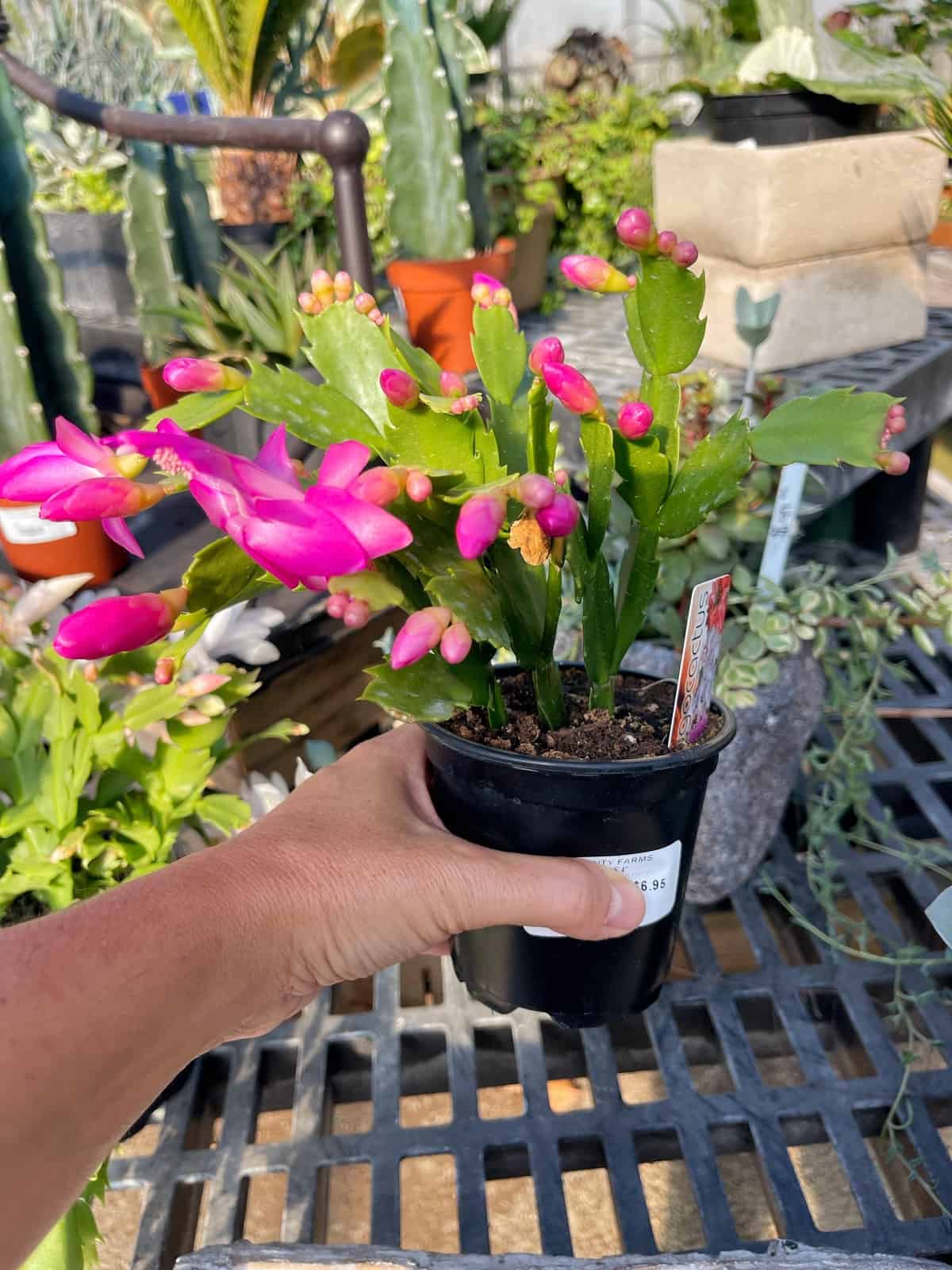Get your Christmas cactus to bloom with this expert guide! Learn about light, watering, soil, and more. Christmas cactus care made easy.
Christmas Cacti, aka Schlumbergera bridgesii, is a small genus of cacti that is super simple to grow. It is a resilient indoor plant that makes a wonderful addition to any decorating aesthetic.
This popular plant propagates pretty easily and if cared for really well, can last a very long time! I’ve had mine for 15 years already and it’s still doing amazing. With proper care, the right amount of water, and indirect sunlight, holiday cactus plants can produce beautiful blooms for decades.
Want to learn more? Here are some Christmas cactus care tips you need to know so you can grow and enjoy these beautiful houseplants.
(Posts on stacyling.com may contain affiliate links. Click HERE for full disclosure.)

About Christmas Cactus
The Christmas cactus is more than just a festive holiday houseplant; it’s a vibrant and long-lasting addition to your home that can grace you with colorful blooms several times a year. Forget those poinsettias that don’t last and are tough to care for.
For a few dollars at your local nursery or even the grocery store, you can snag one of these beauties. They make fantastic, budget-friendly hostess gifts for any occasion, so if you spot one, grab it!
Christmas Cactus vs. Thanksgiving Cactus vs. Easter Cactus: What’s the Difference?
At first glance, they might seem identical, but these holiday cacti are actually distinct plants. The key to telling them apart lies in their leaf segments:
- Christmas Cactus ( Schlumbergera x buckleyi): The edges of the leaf segments have a gentle, scalloped shape.
- Thanksgiving Cactus ( Schlumbergera truncata): The leaf segments have more pronounced, pointed, or claw-shaped edges.
- Easter Cactus ( Schlumbergera gaertnerrii): The leaf segments have rounded edges.
Next time you’re at the nursery, take a closer look – you’ll notice the subtle differences. It’s like a fun botanical puzzle!

Why You Should Grow a Christmas Cactus
Need more convincing? Here are five reasons why a Christmas cactus deserves a spot in your home:
- Easy Care: These plants are low-maintenance and forgiving, perfect for busy plant lovers.
- Beautiful Blooms: Enjoy a vibrant display of flowers indoors, adding a touch of cheer to any space.
- Long Lifespan: With proper care, your Christmas cactus can thrive for decades, becoming a cherished part of your home.
- Air Purification: Like many houseplants, Christmas cactus helps to filter and improve indoor air quality.
- Simple Propagation: Easily grow new plants from cuttings and share the joy with friends and family.

Christmas Cactus Care: A Guide to Thriving Plants
While their name might suggest a desert-dwelling plant, Christmas cacti actually hail from the rainforests of Brazil. They thrive in a humid environment and prefer a bit more TLC than your typical succulent. Here’s how to keep yours happy and blooming:
Light Conditions
Bright, indirect light is ideal. A west-facing window is perfect during the colder months. In summer, you can move your plant outdoors to a shady spot. Just remember to acclimate it gradually and keep it out of direct light to prevent sunburn.
My Christmas cactus enjoys a prime spot in my sunroom, which gets lovely northern and western light. Come summer, I treat it to a vacation on the back porch, where it soaks up the indirect light and fresh air. It seems to love being outdoors, and often rewards me with blooms as soon as I move it outside!
Speaking of moving, I’ve found that my Christmas cactus is pretty adaptable. I used to worry about gradually acclimating it when bringing it back inside before the first frost, but honestly, I just bring it in and it does fine. It’s a tough little plant which is why I recommend it for beginner plant parents!

Soil Requirements
Christmas cacti prefer a well-draining potting mix. A commercial succulent mix works well, or you can create your own by combining two parts potting soil with one part sand or vermiculite. These plants like to be slightly root-bound, so don’t rush to repot. When you do repot, choose a container only slightly larger than the current one.
I only repotted mine in the early years as it grew. And now that it is in a decent size pot, I have left it alone and it’s pretty happy.
Watering
Allow the top inch or two of soil to dry out before watering. The frequency will depend on factors like temperature, light, and humidity. Underwatering is generally better than overwatering. Your cactus will let you know it’s thirsty when the leaves start to pucker.
When to water will vary with the air temperature, amount of light, rate of growth and relative humidity of your home’s microclimate. To give it the optimal care, test the soil for dryness using this method before watering. You could also use this moisture testing meter.
To give you an idea of what I do, I lean towards under-watering my houseplants as opposed to over-watering. During the winter months, I water my Christmas cactus about every other week. When it’s outside and blazing hot out, I probably keep it watered weekly. But I always check the soil first.

Temperature and Humidity
These tropical plants prefer temperatures between 60-70°F (15-21°C). Avoid placing them near drafts or heat sources. To increase humidity, especially during dry winter months, you can use a humidifier or place the pot on a tray of pebbles with water.
Fertilizer
Feed your Christmas cactus with a balanced, water-soluble fertilizer every few months during the growing season (spring and summer).
Common Pests and Diseases
Keep an eye out for common houseplant pests like mealybugs, scale, and spider mites. Root rot can occur if the soil is kept too wet. (Source: University of Wisconsin-Madison Extension [invalid URL removed])

How to Propagate Christmas Cactus
Propagating Christmas cactus is surprisingly easy! Simply take a cutting with 2-3 segments, let it callus for a day or two, and then plant it in moist potting mix.
I propagated the Christmas cactus a few times now, and it was not on purpose! The first time I did it was when a small piece broke off. Instead of tossing it, I stuck it in the soil of another houseplant and it rooted! (I still need to dig it out by the way but that’s for another day.)
Most recently, a large branch broke off while it was flowering. I was devasted it broke but thought I’d try to do what I did before with the smaller piece that rooted. So I added fresh soil to a pot I had laying around and hoped it would eventually root.
I thought the blooms wouldn’t stick around but they did! The branch rooted and it’s become a strong plant today.
Isn’t that so easy?

How to Get Your Christmas Cactus to Rebloom
Contrary to popular belief, Christmas cacti can bloom multiple times a year with the right conditions. Here’s the secret:
- Light and Darkness: To trigger blooming, they need a period of shorter days and longer nights. Aim for 12-14 hours of darkness per day for about 6-8 weeks. You can achieve this by placing the plant in a dark room or covering it with a cloth.
- Cool Temperatures: Cooler temperatures (around 60°F/15°C) also encourage blooming.
- Reduced Watering: Slightly reduce watering during the dormancy period.
There is a lot of information out there that says it will only bloom once a year. I’ve had mine for over 15 years now and my Christmas cactus blooms about 3x per year.
Here’s how I do it.
- I start feeding mine in February with a slow-release fertilizer that will feed for a few months.
- Since I live in Zone 6a, in New Jersey, our last frost date is mid-May. So I will feed it again in May.
- I feed it again in early August.
- And then allow it to go dormant.
My Christmas cactus blooms in May-Junish, August and November. And it’s just gorgeous when it’s in full bloom!
Christmas Cactus Care Growing Tip: Before I started regularly bringing my houseplants outside in summer, my Christmas Cactus did not bloom 2-3x per year – it was maybe more like 1-2x per year. It only started blooming more, once I started bringing it outdoors in summer.

Why Won’t My Christmas Cactus Bloom?
If your Christmas cactus is refusing to flower, the most likely culprits are insufficient light, lack of darkness, or warm temperatures. Pay attention to these factors and adjust accordingly. Bringing your plant outdoors for the summer can also help stimulate blooming.
Because Christmas cactuses prefer to flower in a cooler environment short day cycle, the blooming process needs to be several days of less light to kick of the colorful flowers. And that’s why you see it bloom in November as we approach the holiday season. Since it is a short-day plant it needs hours of darkness to promote flowering.
To initiate flowering, these holiday cacti need at least 8 days of 16 hours of darkness with 8 hours of bright light. So if your environment isn’t providing short days, then Christmas cactus plants may not flower.
You can simulate this by moving it into a dark room without any lights, a dark closet, or warm dry basement for 16 hours a day. And then give it 8 hours of artificial light. I’ve never needed to do this. However, it’s possible that the sheer act of bringing these tropical plants indoors after summer outside, might simulate those conditions because the plant is receiving much less light.
It’s also recommended that since it loves cool temperatures to flower. The ideal temperature should also be set around 61 degrees. I keep my house pretty cool, so I’m fairly certain we are pretty close to that, maybe slightly higher. Just make sure you keep it away from cold or hot drafts.
So, if your holiday cactus plant isn’t blooming? Pay attention to the light and temperature in the space you are caring for it. To encourage it to bloom a few times per year, I strongly suggest bringing it outdoors in summer so it can enjoy the higher humidity level before going back indoors and fertilizing it.

Final Thoughts About Christmas Cactus Care
I hope this guide has inspired you to give Christmas cactus care a try (or to step up your existing routine!). These truly are rewarding plants that bring so much joy to any home. I’d love to hear about your experiences with Christmas cacti. Share your tips, tricks, and photos in the comments below!
For more information about Christmas Cactus care, please read this article from Michigan State University Cooperative Extension.
To drill down on houseplant care basics and growing an indoor garden that thrives, please read my articles:
- Easy Houseplants for Busy People: The Low-Maintenance Approach to Growing an Indoor Garden
- From Shop to Home: How to Acclimate Your Tropical Plants
- Stop Guessing and Master Watering Indoor Plants Like a Pro
- How to Revive Houseplants You Thought Were Goners
- Is Your Houseplant Getting Enough Light? Here’s How to Tell.
Thank you so much for visiting my blog today!
I really appreciate you stopping by.
Enjoy a beautiful day! xo

















